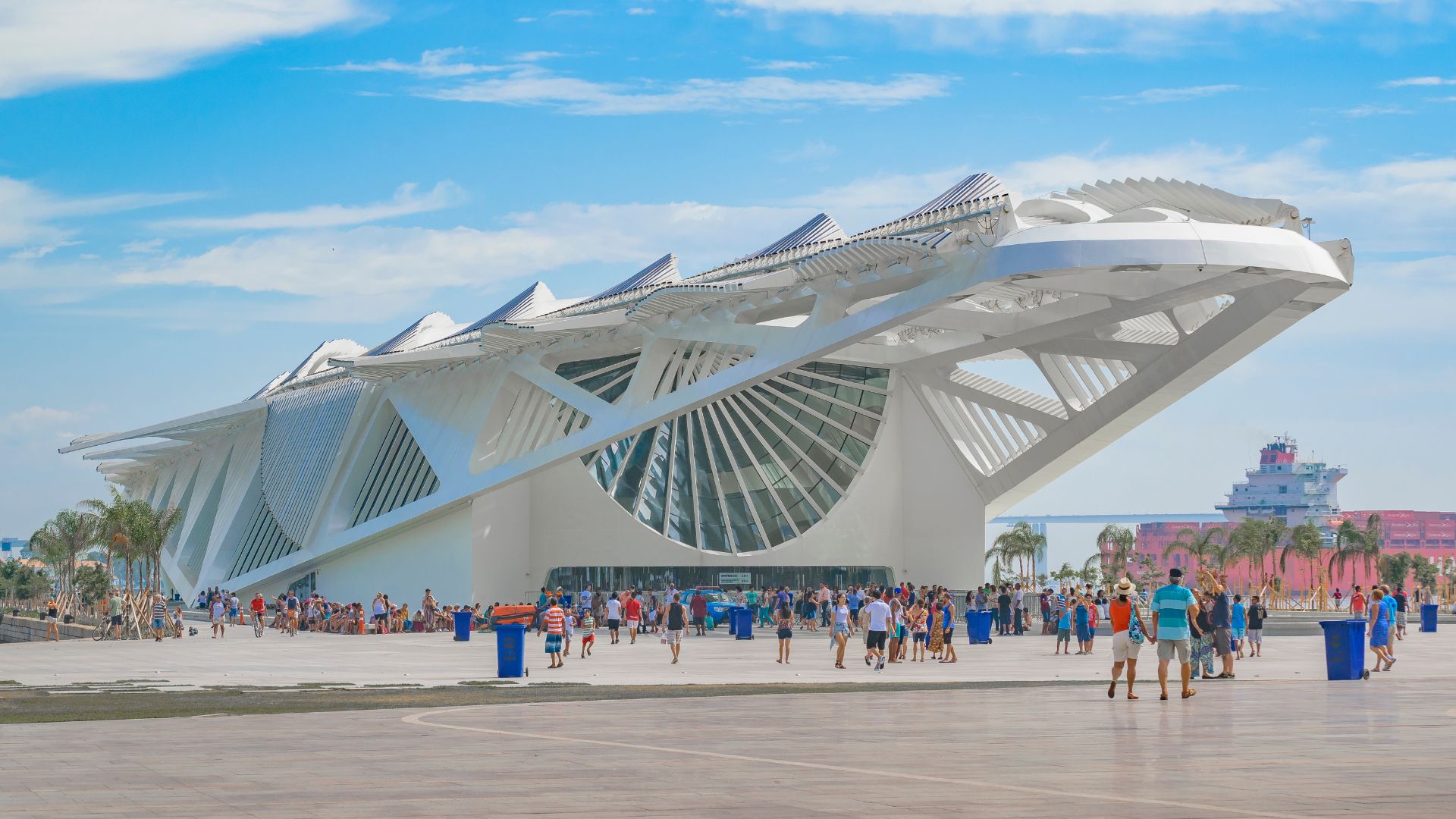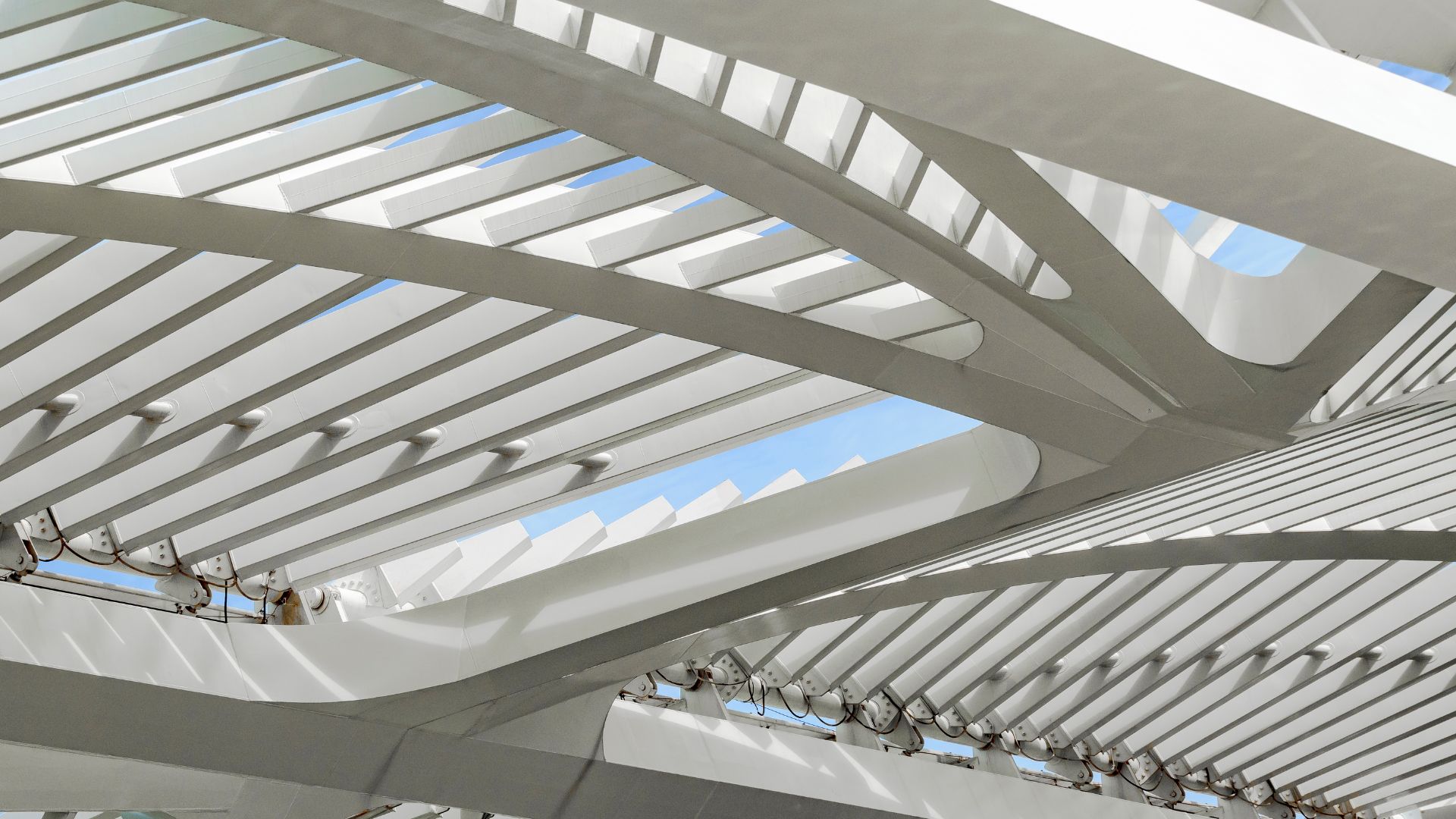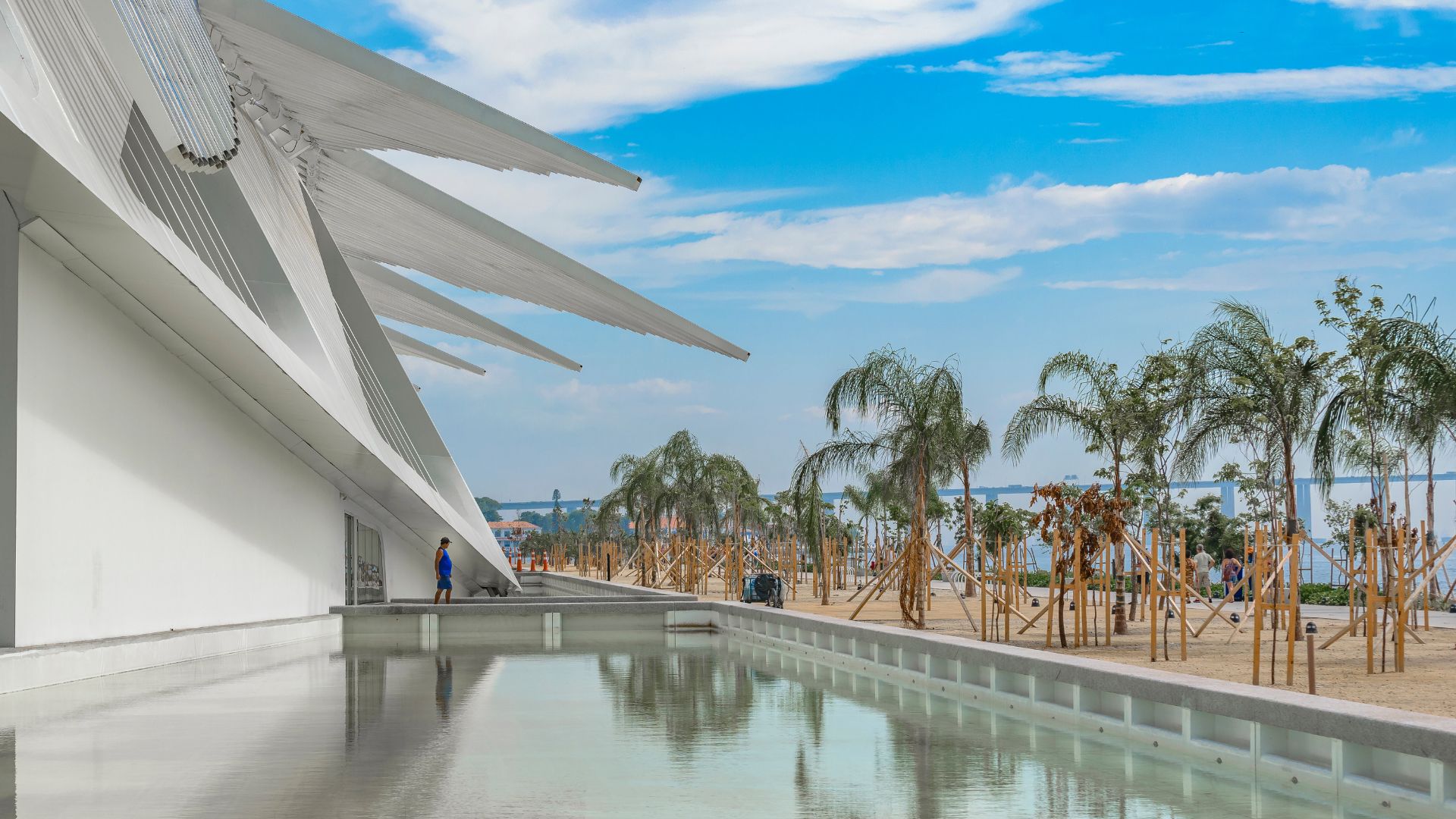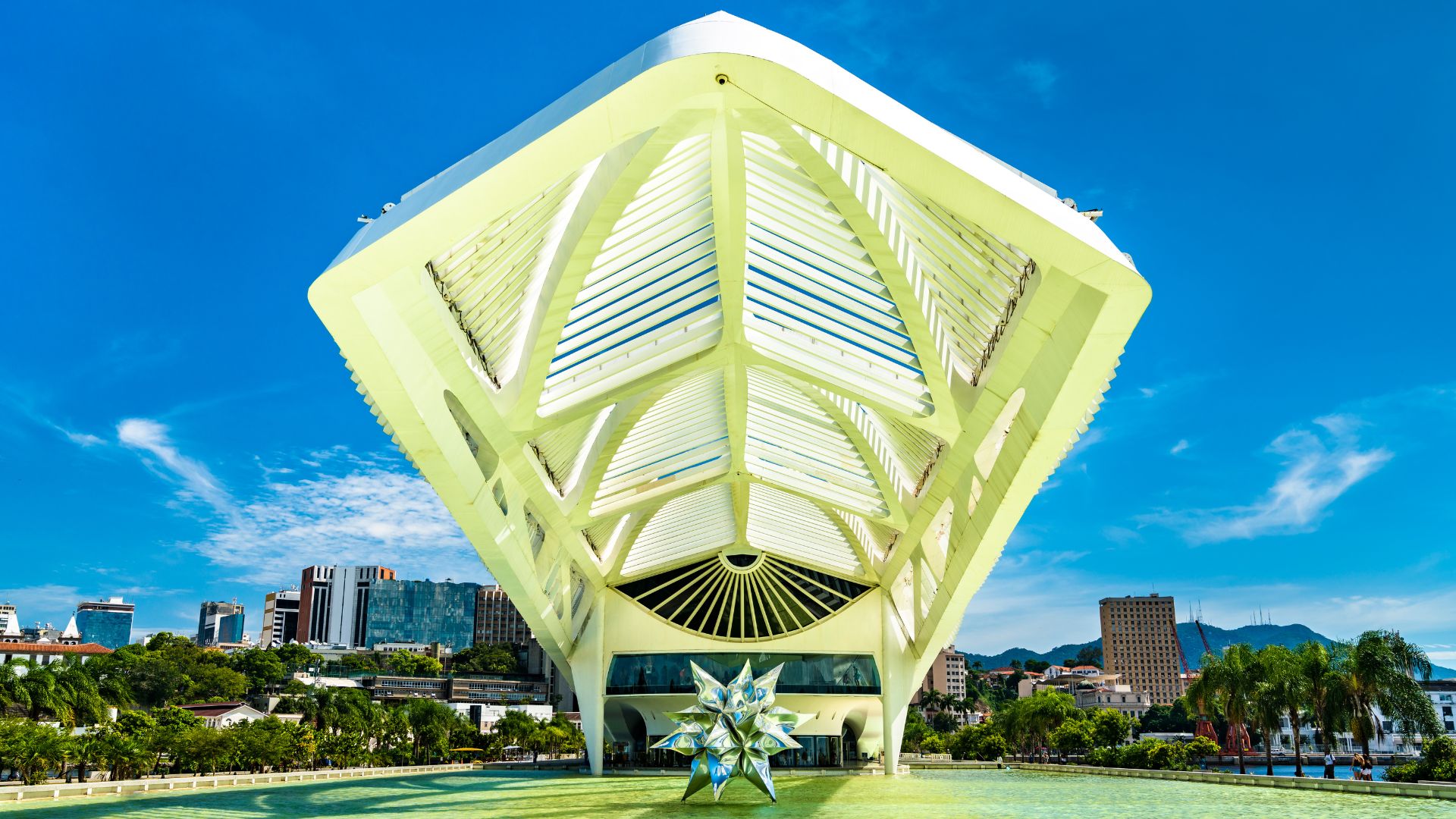The Museum of Tomorrow (Museu do Amanhã) is a breathtaking science museum in Rio de Janeiro that takes you on a journey through humanity’s past, present, and future.
This architectural marvel on Guanabara Bay combines cutting-edge technology, interactive exhibits, and thought-provoking installations to explore the challenges our planet faces and the possibilities that lie ahead.

Highlights:
- Immerse yourself in the cosmic experience for an awe-inspiring journey through space and time
- Interact with digital exhibits using your personal card to explore humanity’s impact on our planet
- Marvel at Eduardo Kobra’s massive “Ethnicities” mural, one of the world’s largest graffiti artworks
Tickets & Prices
Booking in advance for the Museum of Tomorrow is highly recommended to guarantee entry, especially during weekends or holidays.
Full-price admission tickets cost R$30, with half-price options (R$15) available for students, Rio residents, individuals aged 6 to 21, disabled visitors, and specific cardholders like Santander.
Children under 5 years old, senior citizens aged 60 and above, necessary caregivers for disabled visitors, museum employees, ICOM members with valid identification, and tour guides enjoy free entry. Remember to bring appropriate identification to qualify for discounts or free admission.
Tours
Several guided tour options are available for visitors wanting to enhance their Museum of Tomorrow experience.
The Olympic Boulevard tour combines a visit to the museum with exploration of Rio’s revitalized port area, including the famous Kobra Mural.
For those seeking a more comprehensive Rio experience, full-day tours are available that include the Museum of Tomorrow along with iconic sites like Christ the Redeemer and Sugarloaf Mountain.
Tours typically include hotel pickup and drop-off, multilingual guides, and all entrance fees.

Opening Hours
The Museum of Tomorrow welcomes visitors from Thursday to Tuesday, 10 AM to 6 PM, with last entry at 5 PM. The museum is closed on Wednesdays for maintenance.
Both the museum’s coffee shop and store follow the same operating hours as the main facility.
What to See and Do
There’s plenty to explore at the Museum of Tomorrow, from immersive cosmic experiences to thought-provoking exhibits about humanity’s impact on our planet.
Here are the must-see attractions within this futuristic museum.
Explore the Five Main Exhibition Areas
The Museum of Tomorrow’s main exhibition is thoughtfully organized into five distinct areas: Cosmos, Earth, Anthropocene, Tomorrows, and Us. Each section builds upon the last to tell the story of our planet and humanity’s role in shaping its future.
In the Cosmos section, you’ll learn about the origins of the universe and the fundamental forces that govern it.
The Earth area focuses on our planet’s unique characteristics that make life possible.
When you reach the Anthropocene section, you’ll confront the reality of humanity’s impact on Earth’s systems through powerful visual displays and interactive elements.
The Tomorrows section presents possible futures based on current trends and choices, while the Us area encourages personal reflection on how individual actions contribute to collective outcomes.
Throughout these exhibits, you’ll use your personal interactive card to engage with digital stations, making your journey through the museum uniquely your own.
Marvel at the Black Hole Exhibit
One of the museum’s most talked-about installations is the black hole exhibit. This 3D, immersive experience allows visitors to visualize one of the universe’s most mysterious phenomena.
You’ll lie down to fully appreciate the sensory experience as you’re surrounded by a visualization of what it might be like to approach a black hole.
The exhibit combines scientific concepts with artistic interpretation, making complex astrophysics accessible and emotionally engaging. It’s particularly popular with children, who often find the combination of science and spectacular visuals captivating.
Discover Global Traditions in the Cultural Room
Take time to explore the Global Traditions Room, which features photographs and exhibits highlighting cultural celebrations from around the world. From Halloween and St. Patrick’s Day to food contests and beauty pageants, this collection offers a fascinating glimpse into how different societies express their values and identities.
This section provides a welcome contrast to the more science-focused exhibits, reminding visitors that our cultural diversity is as important to humanity’s story as our technological achievements. The visual journey through world cultures helps contextualize the museum’s broader questions about human identity and our collective future.
Interact with Digital Displays and 3D Visual Effects
Unlike traditional museums filled with physical artifacts, the Museum of Tomorrow offers a primarily digital experience. Throughout your visit, you’ll interact with cutting-edge technology that brings abstract concepts to life through stunning visual effects and interactive displays.
When you first enter, you’ll receive a card that you can swipe at various stations to activate personalized activities. These interactions help you engage more deeply with the museum’s content while collecting insights about your own relationship with the topics presented.
The museum’s focus on digital displays and 3D visual effects creates a futuristic atmosphere that perfectly complements its forward-looking themes. Even the architecture of the building, with its clean lines and reflective surfaces, enhances this sense of stepping into tomorrow.
Reflect in the Mirror Rooms
The mirror rooms provide some of the museum’s most photogenic and thought-provoking spaces.
These installations use mirrored walls and extensive visual effects to create environments that seem to extend infinitely, encouraging visitors to contemplate concepts of perspective and infinity.
Some of these spaces incorporate global photography with surreal or unsettling imagery, designed to provoke deeper thinking about humanity’s challenges. The disorienting effect of seeing yourself reflected from multiple angles serves as a powerful metaphor for the museum’s invitation to look at our world from new perspectives.
Enjoy the Views of Guanabara Bay
Don’t miss the opportunity to step outside and appreciate the museum’s stunning location on Guanabara Bay. The exterior of the building is as impressive as its contents, with a reflective pool and gardens that frame views of the water and surrounding cityscape.
The museum’s distinctive white structure, designed by Spanish architect Santiago Calatrava, extends over the water like a living organism. Take a moment to photograph this architectural marvel from different angles and enjoy the refreshing bayside breeze before continuing your exploration of Rio’s revitalized port area.

Directions
The Museum of Tomorrow is located at Praça Mauá, 1 – Centro, Rio de Janeiro. While the nearest subway station is Uruguaiana, the closest tram station is Parada dos Museus, making it easily accessible via public transportation.
The Museum of Tomorrow does not have its own dedicated parking lot. However, there is an independently operated parking garage located directly in front of the museum. It charges a fee, and while convenient, it may not be immediately obvious to first-time visitors.
When planning your visit, allow extra time for finding parking or consider using public transportation or bicycles as recommended by the museum.
Nearby Places
Rio Museum of Art (MAR): Located just a short walk from the Museum of Tomorrow, this cultural institution showcases Brazilian and international art in a modern setting. Its rooftop offers stunning views of Guanabara Bay and the surrounding area.
São Bento Monastery: This historic Benedictine monastery dates back to the 16th century and features impressive baroque architecture and intricate gold-leaf decorations. Its peaceful atmosphere provides a contemplative counterpoint to the futuristic Museum of Tomorrow.
Centro Cultural Banco do Brasil: This former bank building has been transformed into one of Rio’s premier cultural centers, hosting rotating art exhibitions, film screenings, and theatrical performances in a beautifully preserved historic setting.
Confeitaria Colombo: Experience a taste of Rio’s belle époque at this historic café established in 1894. With its ornate mirrors, stained glass, and delicious pastries, it offers a charming glimpse into the city’s past.
Olympic Boulevard: Stretching along the revitalized port area, this pedestrian-friendly zone features the massive Kobra Mural, one of the world’s largest graffiti artworks depicting five ethnic groups in vibrant colors.
Did you know that: (5 Interesting Facts!)
- The Museum of Tomorrow was designed by renowned Spanish architect Santiago Calatrava and cost approximately R$230 million to build.
- The museum’s unique design includes movable “wings” on the roof that adjust to capture solar energy, making it a model of sustainable architecture.
- Unlike traditional museums that collect artifacts from the past, the Museum of Tomorrow focuses on ideas and possibilities for the future, using technology to simulate potential scenarios.
- The museum’s location on Guanabara Bay is part of Porto Maravilha, a massive urban renewal project that transformed Rio’s port area for the 2016 Olympics.
- The interactive card given to visitors at the Museum of Tomorrow collects data on their interactions throughout the exhibits, creating a personalized experience that evolves during their visit.

History:
- December 2015: The Museum of Tomorrow officially opens to the public as part of Rio de Janeiro’s port area revitalization project.
- 2016: The museum becomes a centerpiece of Rio’s cultural offerings during the Summer Olympic Games, attracting international attention.
- 2017: The Museum of Tomorrow wins the “Best New Museum of the Year” award from the Leading Culture Destinations Awards in London.
- 2018: The museum launches its “Anthropocene” exhibition, exploring humanity’s impact on Earth’s systems through interactive displays.
- 2019: The Museum of Tomorrow reaches the milestone of 3 million visitors since its opening, establishing itself as one of Brazil’s most popular cultural institutions.
- 2020-2021: During the COVID-19 pandemic, the museum develops virtual experiences to continue engaging with audiences remotely.
- 2022: The museum introduces new technologies and exhibitions focused on climate change and sustainable development goals.
- Present Day: The Museum of Tomorrow continues to evolve its exhibitions and programs, exploring the challenges and possibilities that humanity faces in coming decades.
FAQ
Is the Museum of Tomorrow in Rio kid-friendly?
Yes, the Museum of Tomorrow is very kid-friendly despite its educational focus. Children particularly enjoy the black hole experience and interactive exhibits, making it an excellent place to introduce them to science, space, and global culture in an engaging way.
How much time should I allow for visiting the Museum of Tomorrow?
Most visitors spend between 2-3 hours exploring the Museum of Tomorrow. While some reviews mention shorter visits, to fully experience all exhibits and interactive elements, particularly during busy periods, it’s best to allocate at least half a day.
Do I need to book tickets in advance?
Advance booking is required as visitors cannot simply walk in without a reservation. During peak tourist seasons, showing up without a booking means you’ll need to purchase tickets online via your phone at the outdoor totems, potentially waiting in the heat.
Is the Museum of Tomorrow accessible for disabled visitors?
Yes, the Museum of Tomorrow is designed with accessibility in mind, accommodating a range of needs. It features tactile floors and dioramas for visually impaired visitors, ramps and elevators for those with limited mobility, adapted bathrooms, baby changers, and universal signage throughout.
Can I take photographs inside the Museum of Tomorrow?
Photography is allowed in most areas of the museum except for the Cosmos exhibition. The use of flash and selfie sticks is prohibited throughout the museum to protect the exhibits and avoid disturbing other visitors.